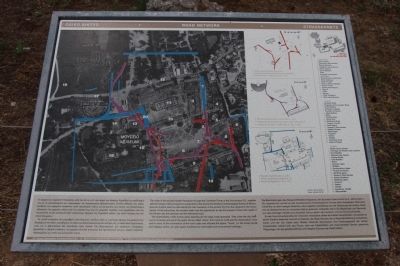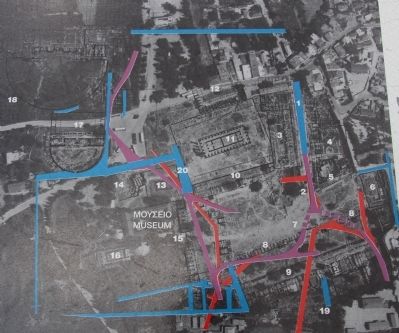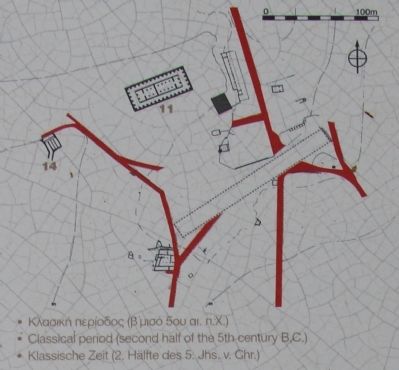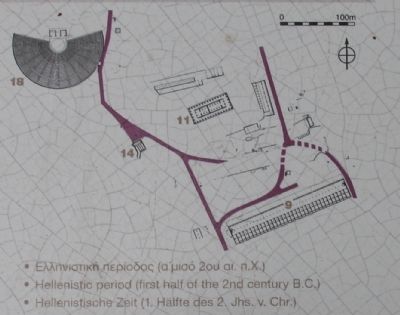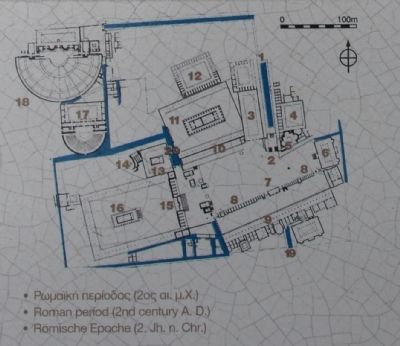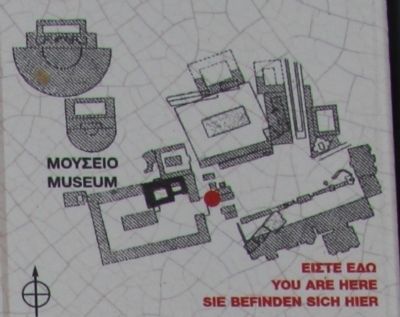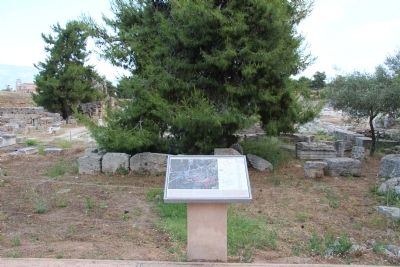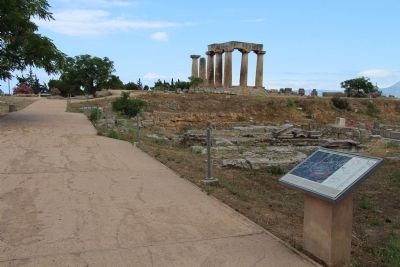Archea Korinthos in Korinthos, Peloponnese, Western Greece and the Ionian, Greece — Ελλάδα (Southeastern Europe, Balkan Peninsula)
Road Network
The characteristic of the roman urban planning are the large roads (avenues). They cross the city, intersect in its center and end in the gates: the so called "cardo", from north to south and the "decumanus", from east to west. At the intersection of the main roads was situated the Agora, "forum", i.e. the main social and religious center, an open space, bordered by colonnades and monumental buildings.
Erected by LZ Ephoreia of Prehistoric & Classical Antiquities.
Topics. This historical marker is listed in these topic lists: Roads & Vehicles • Settlements & Settlers.
Location. 37° 54.318′ N, 22° 52.735′ E. Marker is in Archea Korinthos, Peloponnese, Western Greece and the Ionian, in Korinthos. Marker can be reached from Enotiki Archeas Korinthou north of EO Korinthou Argous (Local Route 7), on the left when traveling north. This marker is located in the Archaeological Park of Ancient Corinth, and is one of the early markers that visitors encounter upon first entering the archaeological park and is situated very near the east side of the park's visitor center and site museum. Touch for map. Marker is in this post office area: Archea Korinthos, Peloponnese, Western Greece and the Ionian 200 07, Greece. Touch for directions.
Other nearby markers. At least 8 other markers are within walking distance of this marker. Buildings at the West End of Roman Agora (within shouting distance of this marker); Temple of Apollo (within shouting distance of this marker); Temple E (about 90 meters away, measured in a direct line); Glauke Fountain (about 90 meters away); Ancient Corinth (about 90 meters away); Archaeological Site of Ancient Corinth (about 90 meters away); The Rostra (Bema) of the Roman Forum (about 120 meters away); The Heroon at the Crossroads: an early sanctuary of Ancient Corinth (about 120 meters away). Touch for a list and map of all markers in Archea Korinthos.
More about this marker. With regards to the location of all of the markers in the Archaeological Park of Ancient Corinth, when going online and researching directional information, I could not locate any websites, or any online maps, that provided the names of the local streets, so it was difficult for me to provide accurate
and detailed directional information. The street and crossroad that I have provided are the closest two "named" streets that I could locate on any of the maps that I used.
One online site provided the following directions for getting to the archaeological park: "By car: 90 minutes from Athens. The exit to Ancient Corinth, approaching from the north, is about 2 kilometers west of the Tripolis interchange. Warning: visitors familiar with the village before 1996 should take the Patras interchange not the new Tripolis highway to arrive from the other side of the village; no exit was constructed and a U-turn cannot be made for ten kilometers."
Related markers. Click here for a list of markers that are related to this marker. To better understand the relationship, study each marker in the order shown.
Credits. This page was last revised on March 22, 2022. It was originally submitted on July 1, 2015, by Dale K. Benington of Toledo, Ohio. This page has been viewed 391 times since then and 15 times this year. Photos: 1, 2, 3, 4, 5, 6, 7, 8, 9. submitted on July 1, 2015, by Dale K. Benington of Toledo, Ohio.
